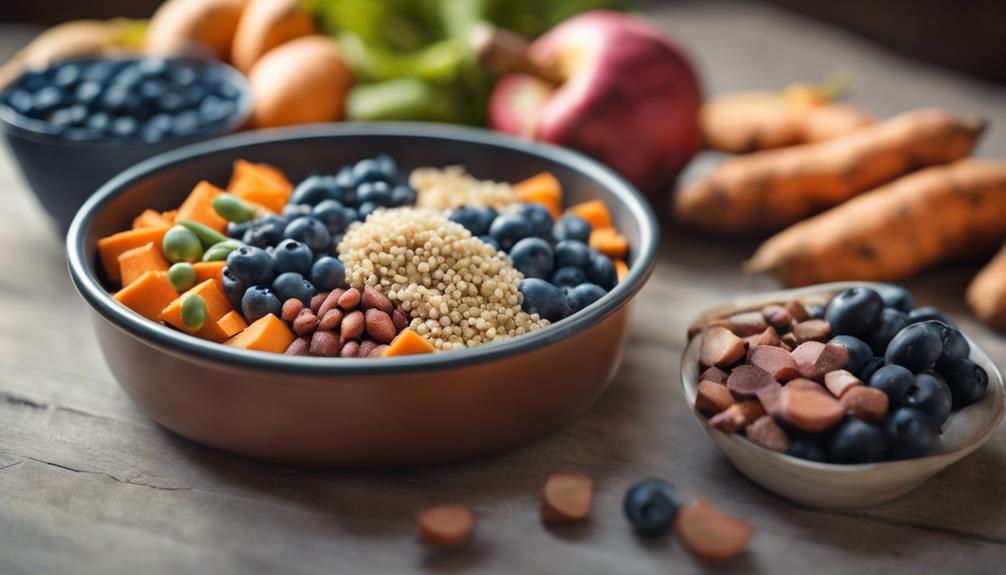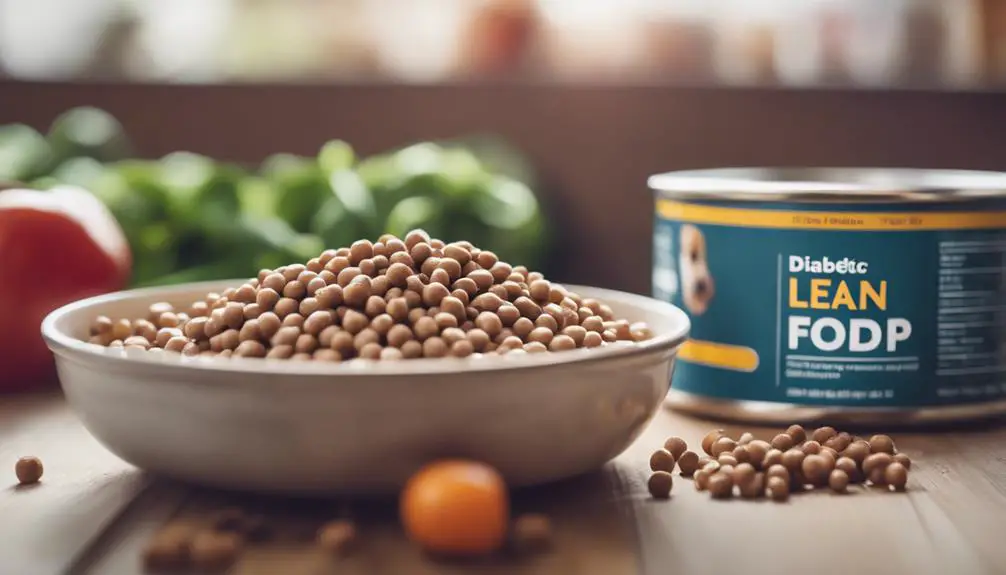What Can Diabetic Dogs Eat
For your diabetic dog, focus on consistency in meal timing, portion control, and balanced nutrition. Opt for lean meats like chicken or turkey, plant-based proteins such as lentils, and low-glycemic veggies like broccoli. Include healthy fats with fish oil, limit saturated fats, and select complex carbs like sweet potatoes. Moderation is essential to maintaining stable blood sugar levels. Avoid sugary treats and consult your vet before diet changes. By prioritizing your furry friend's diet with these guidelines, you can promote their health and well-being. Remember, your vet can offer tailored advice for your diabetic dog's specific needs.
Key Takeaways
- Opt for lean protein sources like chicken and fish.
- Include low-glycemic vegetables such as broccoli and spinach.
- Incorporate healthy fats like fish oil for omega-3 benefits.
- Choose balanced carbohydrates like sweet potatoes and quinoa.
- Consult a vet for personalized dietary recommendations.
Diabetic Dog Diet Basics

When managing diabetes in your dog, it's important to understand the basics of their diet. Consistency in meal timing and portion control are necessary. Providing your furry friend with balanced nutrition is key. Consider incorporating nutritional supplements to support their overall health. These supplements can help bridge any nutritional gaps that may exist in their diet. Portion control plays an important role in managing your diabetic dog's weight and blood sugar levels. By feeding them consistent amounts at regular times, you can help stabilize their glucose levels. Remember, always consult your veterinarian before making any significant changes to your dog's diet. Your vet can provide expert guidance tailored to your dog's specific needs.
Protein-Rich Foods
When it comes to feeding your diabetic dog, opting for protein-rich foods is essential. Lean meat options such as chicken, turkey, and fish can be excellent choices to regulate blood sugar levels while providing essential nutrients. Additionally, consider incorporating plant-based protein sources like lentils, chickpeas, and quinoa to diversify your furry friend's diet and promote overall health.
Lean Meat Options
For diabetic dogs, incorporating lean meat options into their diet provides essential protein for their overall health and well-being. When choosing meat alternatives for your furry companion, opt for lean cuts such as skinless poultry, lean beef, or fish. These sources of protein help maintain muscle mass and provide energy without excessive fat content. When preparing these meats, opt for healthy cooking methods like boiling, baking, or grilling instead of frying. These methods help retain the nutrients while reducing added fats that can be harmful to diabetic dogs. By including lean meat options in your diabetic dog's diet and preparing them thoughtfully, you can make sure they receive the necessary protein for a balanced and healthy lifestyle.
Plant-Based Protein Sources
Consider integrating plant-based protein sources into your diabetic dog's diet to provide essential nutrients and variety to their meals. Plant-based proteins can be a healthy alternative for diabetic dogs, offering a range of benefits. Here are some options to explore:
- Nutrient-Rich Legumes: Legumes like lentils, chickpeas, and peas are excellent sources of plant-based protein for diabetic dogs. They are rich in fiber, vitamins, and minerals, promoting overall health.
- Delicious Grains: Whole grains such as brown rice, quinoa, and barley can provide diabetic dogs with additional protein and energy. These grains are also packed with essential nutrients that support a balanced diet.
Including these plant-based protein sources in your dog's meals can help manage their diabetes while ensuring they receive the necessary nutrients for their well-being.
Low-Glycemic Vegetables

When it comes to managing your diabetic dog's diet, incorporating low-glycemic vegetables can play an important role. Ideal choices like broccoli, spinach, and green beans can help regulate blood sugar levels effectively. Monitoring your furry friend's blood sugar response to these veggies is key to maintaining their health and well-being.
Ideal Vegetable Choices
Choosing low-glycemic vegetables is essential for managing your diabetic dog's diet effectively. When selecting vegetables for your furry companion, opt for those that have a minimal impact on blood sugar levels. Here are some ideal vegetable choices that can be beneficial for your diabetic dog:
- Carrot sticks: These crunchy treats are not only low in sugar but also high in fiber, making them a great snack option.
- Broccoli florets: Packed with essential nutrients and antioxidants, broccoli is a fantastic addition to your dog's diet.
- Spinach salad: Rich in vitamins and minerals, spinach can be a tasty and nutritious part of your diabetic dog's meal.
- Zucchini noodles: A low-carb alternative to traditional pasta, zucchini noodles can help keep your dog's blood sugar stable while adding variety to their diet.
Monitoring Blood Sugar
To ensure your diabetic dog's blood sugar remains stable, incorporating low-glycemic vegetables into their diet is vital for effective monitoring. These veggies have a slow impact on blood sugar levels, helping to prevent spikes. Some excellent choices include broccoli, green beans, and cauliflower. Not only do these vegetables provide essential nutrients, but they also support weight management, another important aspect of diabetes care for your furry friend. Regular monitoring of your dog's blood sugar levels is essential. This can be done through at-home testing kits or with the help of your veterinarian. Remember, exercise benefits diabetic dogs by aiding in weight control and improving insulin sensitivity. By combining a balanced diet with regular monitoring and exercise, you can help your diabetic dog lead a healthier, happier life.
Healthy Fats
Incorporate healthy fats like fish oil into your diabetic dog's diet to support their overall well-being. When choosing fats for your furry friend, opt for those rich in omega-3 fatty acids to promote heart health and reduce inflammation. Here are some tips to help you include healthy fats in your diabetic dog's meals:
- Choose Fish Oil: Consider adding a fish oil supplement to your dog's food to boost their omega-3 intake.
- Limit Saturated Fats: Avoid feeding your diabetic dog foods high in saturated fats to maintain a balanced diet.
- Consult Your Vet: Always consult your veterinarian before making significant changes to your dog's diet, especially if they have diabetes.
- Portion Control: Pay attention to portion sizes when adding fats to your dog's meals to prevent overfeeding and weight gain.
Balanced Carbohydrates

When planning your diabetic dog's diet, make sure to include a balance of carbohydrates to help regulate their blood sugar levels effectively. Opt for complex carbohydrates like sweet potatoes, peas, and lentils over simple sugars to provide sustained energy without causing sharp spikes in blood glucose. These carb choices are rich in fiber, which offers various benefits such as aiding digestion and promoting feelings of fullness. Incorporating whole grains like brown rice or quinoa can also be beneficial. Remember, portion control is key to managing your diabetic dog's carbohydrate intake, so be mindful of serving sizes. Additionally, consider meal timing to spread out carbohydrate consumption throughout the day, helping to maintain stable blood sugar levels for your furry friend.
Moderation Is Key
Moderation plays an essential role in managing your diabetic dog's diet effectively to guarantee stable blood sugar levels. When caring for your furry friend, remember these important points:
- Meal timing: Consistency in feeding times helps regulate blood sugar levels throughout the day.
- Portion control: Controlling the amount of food your diabetic dog consumes is essential in managing their diabetes.
- Exercise regimen: Regular physical activity is key to helping your dog maintain a healthy weight and stabilize blood sugar levels.
- Weight management: Keeping your diabetic dog at a healthy weight reduces the risk of complications associated with diabetes.
Avoid Harmful Treats

To guarantee your diabetic dog's health and well-being, be mindful of avoiding harmful treats that can negatively impact their condition. Opt for treat alternatives that are specifically designed for diabetic dogs, ensuring they are low in sugar and high in fiber. Practice portion control to prevent unnecessary spikes in blood sugar levels. Look for sugar-free options that are safe for diabetic pets, such as carrots, green beans, or blueberries. These snacks can be a tasty and healthy alternative to traditional treats. Remember, what your diabetic dog eats greatly affects their overall health, so always choose wisely when it comes to giving them treats. Your furry friend will thank you for it in the long run.
Consult With a Vet
Consider reaching out to a veterinarian for guidance on managing your diabetic dog's diet and overall care. Your vet can provide valuable insights tailored to your furry friend's specific needs. Here are four essential areas where your vet can offer expert advice:
- Meal Planning: Vets can help create a balanced meal plan that takes into account your diabetic dog's nutritional requirements.
- Blood Sugar Management: They can guide you on monitoring your dog's blood sugar levels and adjusting their diet accordingly.
- Insulin Dosage: Vets can assist in determining the correct insulin dosage for your diabetic dog based on their individual condition.
- Dietary Supplements: Your vet may recommend specific dietary supplements to support your dog's overall health and well-being.

If Richie Bedard is a dog food expert, author, or any other figure in the field of dog nutrition that emerged after September 2021,






